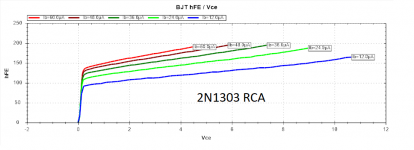Hi,
I plan to design and build a microphone pre-amplifier using germanium transistors. Devices that I feel would be suitable are looking very difficult to track down.
I need the transistors to be able to withstand VCE of over 24v and can be found in relatively large numbers or still be being manufactured today. Does anyone know of devices that could be suitable?
Cheers
I plan to design and build a microphone pre-amplifier using germanium transistors. Devices that I feel would be suitable are looking very difficult to track down.
I need the transistors to be able to withstand VCE of over 24v and can be found in relatively large numbers or still be being manufactured today. Does anyone know of devices that could be suitable?
Cheers
I did a search for a guy that had a Farfisa organ where the Ge transistors had rusted the steel leads and cases off. All the results for Ge came back as germanium doped silicon RF transistors, not germanium transistors as such. You would do better cruising the flea market and buying early sixties battery am radios and record players, or very early non-tube organs. Germanium was horribly temperature sensitive, very unstable.
Germanium has it's charms 
RS Components | Electronic and Electrical Components Your search for germanium
RS Components | Electronic and Electrical Components Your search for germanium
Why germanium? Very few Ge devices are still made, possible none at all?
What can Ge do, which can't also be done by silicon or vacuum devices?
I agree, Si is better in every respect. Ge transistors have horrible leakage which makes for horrible thermal run-away.
Bobby Dipole
A preamp from a company called Chandler is currently getting rave reviews in some quarters. Some are claiming that it gives 'digital' recordings an 'analog tape' sound. It apparently makes use of germanium transistors. Chandler produce a range of recording ancillaries such as compressors and preamps, some based on legacy designs.
w
w
What is germanium sound? Temperature-dependent noise from leakage currents? Spikes from tin whiskers?
Not at all
http://www.diyaudio.com/forums/headphones/160646-germanium-single-ended-class-headphone-amp.html
A physical property of Ge is that it has much higher electron mobility than Si. Whether that plays a part in "subjectivity" I don't know. You can't fiddle that effect in any way by adding Ge diodes to Si. Whether that plays a part in "subjectivity" I don't know.
I very much doubt that electron mobility is a significant factor at low frequencies (audio) and low power (headphones). This sounds like just another attempt to start a fashion for mild effects boxes masquerading as preamps. If you put "digital sound" in and get "analogue sound" out then it has fiddled with the signal and is therefore an effects box. Will "germanium sound" now replace "tube sound" ?
Germanium Transistors
There is an audible sound difference between germanium and silicone transistors (it appears that all together germanium devices have lower intermodulation distortion and this is giving "clean" sound similar to tube pre-amps). The best possible transistors for that purpose were AC151r and they were used in professional equipment (for example "Uher 4400 Report Stereo" tape recorder, non-IC version). They were also used in mixing consoles/phono pre-amps from late sixties/early seventies (by "Grundig","Telefunken" etc.). They have been replaced by silicone BC549c NPN/BC559c PNP. For example, AKG is using these silicone transistors in their built-in mike-preamps for the model 1000S. The orientation in this design is about 50uA (micro-amps) collector current and 10:1 max. ratio between collector and emitter resistor with no shunting capacitor (feedback) for the lowest noise levels.
There is an audible sound difference between germanium and silicone transistors (it appears that all together germanium devices have lower intermodulation distortion and this is giving "clean" sound similar to tube pre-amps). The best possible transistors for that purpose were AC151r and they were used in professional equipment (for example "Uher 4400 Report Stereo" tape recorder, non-IC version). They were also used in mixing consoles/phono pre-amps from late sixties/early seventies (by "Grundig","Telefunken" etc.). They have been replaced by silicone BC549c NPN/BC559c PNP. For example, AKG is using these silicone transistors in their built-in mike-preamps for the model 1000S. The orientation in this design is about 50uA (micro-amps) collector current and 10:1 max. ratio between collector and emitter resistor with no shunting capacitor (feedback) for the lowest noise levels.
There is a very good reason why early solid-state equipment used germanium transistors. There is an equally good reason why later equipment used silicon (not "silicone" - that is floor polish or car wax!). In each case they were using the best devices currently available.
Almost all SS equipment is designed with lots of negative feedback so the end result does not depend on the characteristics of the devices - which on their own are very nonlinear. About the only exception is where signals are so small that BJT exponential distortion is small enough to be ignored.
Almost all SS equipment is designed with lots of negative feedback so the end result does not depend on the characteristics of the devices - which on their own are very nonlinear. About the only exception is where signals are so small that BJT exponential distortion is small enough to be ignored.
I have several Corning pH meters -- wanted them for the huge ammeter -- yesterday I pulled 5 germanium transistors off the PCB. Measured on my Leak, one has gain of almost 2,500.
These pH meters also have a pencil-tube.
Will probably just sell the transistors on EBay -- they have nice nylon standoffs!
These pH meters also have a pencil-tube.
Will probably just sell the transistors on EBay -- they have nice nylon standoffs!
- Status
- This old topic is closed. If you want to reopen this topic, contact a moderator using the "Report Post" button.
- Home
- Source & Line
- Analog Line Level
- Germanium transistors for a preamplifier
